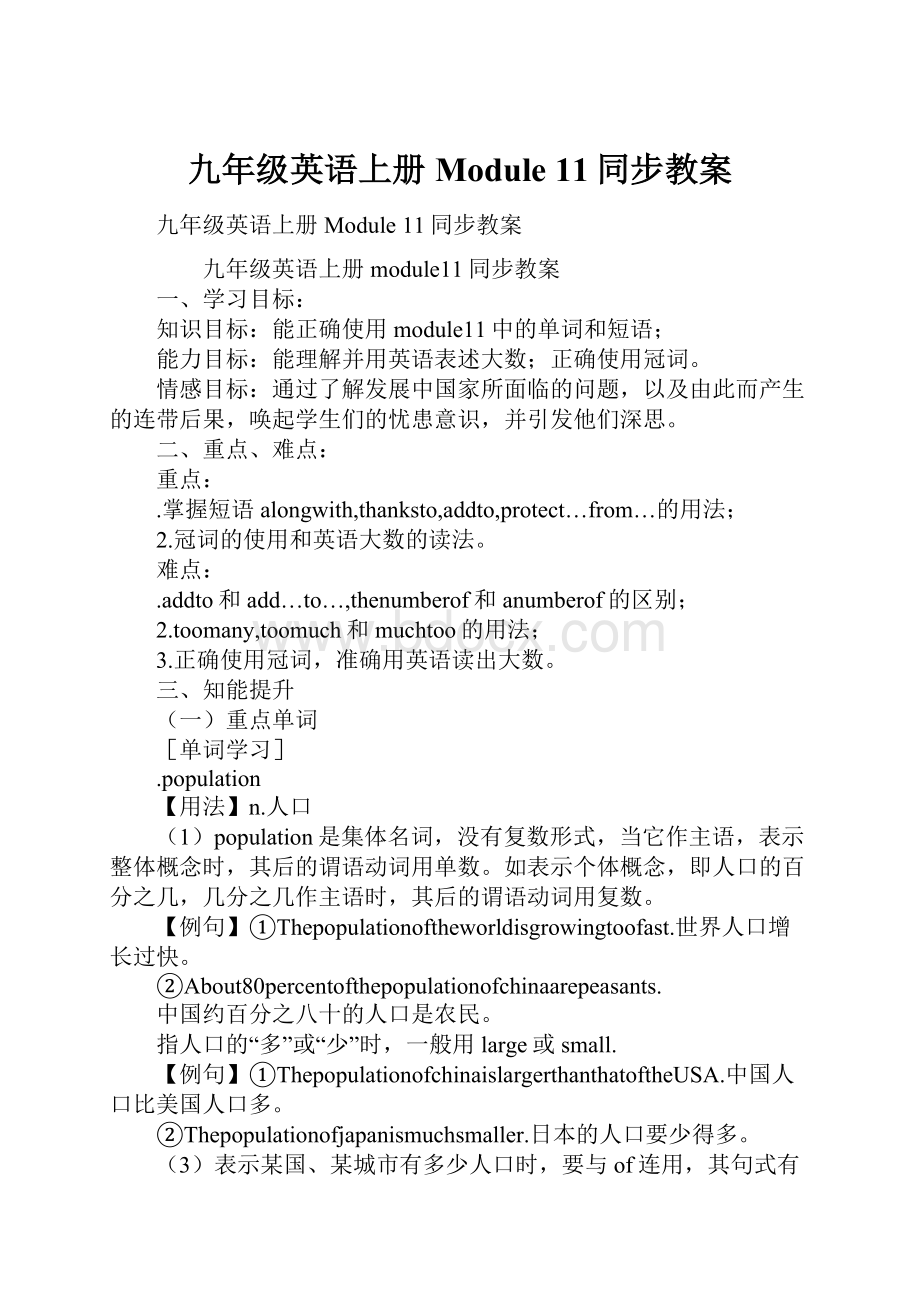九年级英语上册Module 11同步教案.docx
《九年级英语上册Module 11同步教案.docx》由会员分享,可在线阅读,更多相关《九年级英语上册Module 11同步教案.docx(19页珍藏版)》请在冰豆网上搜索。

九年级英语上册Module11同步教案
九年级英语上册Module11同步教案
九年级英语上册module11同步教案
一、学习目标:
知识目标:
能正确使用module11中的单词和短语;
能力目标:
能理解并用英语表述大数;正确使用冠词。
情感目标:
通过了解发展中国家所面临的问题,以及由此而产生的连带后果,唤起学生们的忧患意识,并引发他们深思。
二、重点、难点:
重点:
.掌握短语alongwith,thanksto,addto,protect…from…的用法;
2.冠词的使用和英语大数的读法。
难点:
.addto和add…to…,thenumberof和anumberof的区别;
2.toomany,toomuch和muchtoo的用法;
3.正确使用冠词,准确用英语读出大数。
三、知能提升
(一)重点单词
[单词学习]
.population
【用法】n.人口
(1)population是集体名词,没有复数形式,当它作主语,表示整体概念时,其后的谓语动词用单数。
如表示个体概念,即人口的百分之几,几分之几作主语时,其后的谓语动词用复数。
【例句】①Thepopulationoftheworldisgrowingtoofast.世界人口增长过快。
②About80percentofthepopulationofchinaarepeasants.
中国约百分之八十的人口是农民。
指人口的“多”或“少”时,一般用large或small.
【例句】①ThepopulationofchinaislargerthanthatoftheUSA.中国人口比美国人口多。
②Thepopulationofjapanismuchsmaller.日本的人口要少得多。
(3)表示某国、某城市有多少人口时,要与of连用,其句式有两种:
①Thepopulationof+某国(某城市)+is…
②某国(某城市)hasthe/apopulationof…。
有时,“有多少人口的城市”用acitywithapopulationof…来表示。
【例句】①ThepopulationofAustraliais19,400,000.=Australiahasapopulationof19,400,000.
②Beijingisacitywithapopulationofmorethantenmillion.
提问“有多少人口”时,需用特殊疑问词what,而不用howmany或howmuch。
【例句】what’sthepopulationofthiscity?
这个城市有多少人口?
【考查点】人口的“多”或“少”的表达以及询问人口有多少的句式。
【易错点】人口的“多”或“少”误用many或few及用howmany与population搭配。
【考题链接】TheexpertsthinkthatIndia’spopulationmaybe_________thanchina’s________2020.
A.many,byBmore,inc.larger,by
答案:
c.
解题思路:
此题考查人口的“多”或“少”的表达,由于题目中有than,要用比较级,故先排除A;而指“人口多”时要用large,故选c。
2.increase
【用法】v.增加,增大
【例句】Thenumberofstudentshasincreased.学生的人数增加了。
注意:
increaseto…增加到……increaseby增加了……
【例句】Theproductionofironhasincreasedto120milliontons,whichmeansthatithasincreasedby20%。
铁的产量已增加到一亿两千万吨,意思是说它增加了20%。
【考查点】increaseto…和increaseby的区别。
【易错点】错用介词。
【考题链接】
棉花的产量增加了10%。
Thecottonoutputhas____________________________10%.
答案:
increasedby。
解题思路:
此题考查“增加了”的翻译,由于前面有has,所以increase要用其过去分词形式,故写为increasedby。
3.crowd
【用法1】n.人群
用作名词时,其为集合名词。
作主语时,其谓语用单数或复数均可。
【例句】①Thecrowdmoveson,andnoonetriestostopit.人群向前移动,谁也没试图阻止。
②Thecrowdwererunninginalldirections.人群往四面八方跑去。
强调人数多时,可用其复数形式。
如:
Therewerecrowdsofpeoplewaitingtogetin.有许多人在等着进去。
【用法2】v.“聚集”、“挤满”
【例句】①Peoplecrowdedroundtogetabetterview.人们争相围观。
②Shopperscrowdedthestreets.买东西的人挤满了大街。
常用结构becrowdedwith
【例句】①Thehallwascrowdedwithpeople.大厅挤满了人。
②Theexhibitionwascrowdedwithvisitors.展览会挤满了参观的人。
此外,派生形容词crowded意为“拥挤的”。
如
crowdedtrains拥挤的火车
【考查点】crowd不同词性的用法。
【易错点】词性不同时意思不明确。
【考题链接】
whenabuscomes,the____________atthebus-stoprushesandpushestogeton.
A.people
B.crowd
c.police
答案:
B。
解题思路:
此题考查名词。
由于句中所给谓语是rushesandpushes,用了单数,而people和police都是复数名词,其谓语要用复数,故选B。
4.police
【用法】n.警察
police是警察的统称,包括policemen和policewomen,一般用作复数,作主语时,其谓语要用复数。
如要表示“一个警察”,则用apoliceman来表达。
【例句】Thepolicearelookingfortherobber.警察(方)正在寻找盗贼。
【考查点】词意理解。
【易错点】作主语时谓语误用单数。
【考题链接】
Thepolice_____________searchingforthethiefeverywhere.
A.was
B.are
c.is
答案:
B。
解题思路:
此题考查police的用法,其作主语时,谓语要用复数,故选B。
[即学即练]
①—________isthepopulationofyourcity?
—Abouttwomillion.
A.How
B.what
c.Howmany
②Thepolice__________lookingforthemanwhokilledsomeonelastnight.
A.is
B.are
c.will
③Thethingsinthesupermarketareverycheap,soitisalwaysc______________.
④他们学校学生的数量已增加到了三千人。
Thenumberofthestudentsintheirschoolhas____________________________3,000.
(二)重点短语
[短语学习]
.alongwith
【用法】连同,跟……一起
alongwith相当于一个并列连词,当其连接并列主语时,谓语动词的数取决于充当主语的第一个名词的数。
与此用法类似的短语还有togetherwith,aswellas.
【例句】Theteacheralongwithhisstudentshasgonetotheconcert.
那位老师连同他的学生一起看演唱会去了。
【考查点】alongwith连接并列主语时的用法。
【易错点】不能确定其谓语的单复数。
【考题链接】
Look,thewomanalongwithtwogirls________playinggamesinthepark.
A.are
B.is
c.havebeen
答案:
B.
解题思路:
此题考查alongwith连接并列主语时的用法。
由于“AalongwithB”这一结构作主语时,谓语动词的数取决于A的数的变化,故选B。
2.thanksto
【用法】“由于,多亏”(=becauseof)
这一短语中,thanks是名词,to是介词。
【例句】Thankstothedoctor,theboywassaved.多亏了医生,那男孩得救了。
【考查点】短语本意。
【易错点】误以为thanks是thankyou的意思。
【考题链接】
______________thegovernment’sefforts,ourlifeisbecomingbetterandbetter.
A.Insteadof
B.Accordingto
c.Thanksto
答案:
c。
解题思路:
此题意为“多亏了政府的努力,我们的生活正变得越来越好”,故选c。
3.addto
【用法】“增加,增添”(此处to为介词,其后接名词,代词)
【例句】Fireworksaddedtotheattractionofthefestivalnight.
焰火使节日之夜更加生色。
add…to…把……加入到……
如:
Sheaddedsugartohertea.她往她的茶里加了糖。
【考查点】addto与add…to…的区别。
【易错点】addto与add…to…的意思混淆不清。
【考题链接】坏天气更增加了我们的困难。
Thebadweatheronly______________________ourdifficulties.
答案:
addedto。
解题思路:
此题考查“增加了”的翻译,故写addedto。
4.protect…from…
【用法】“保护……不受……侵害”(from后接名词,代词等作宾语)
【例句】It’smydutytoprotectchildrenfromharm.保护孩子免受伤害是我的责任。
【考查点】短语本意。
【易错点】不会灵活翻译。
【考题链接】
Heiswearinghissunglassesto__________himselffromthesun.
A.prevent
B.stop
c.protect
答案:
c。
解题思路:
此句意为“他戴太阳镜使自己免受太阳光的侵害”,prevent和stop与from构成的是prevent/stopsbfromdoingsth.意为“阻止某人做某事”,故选c。
5.anumberof
【用法】“许多”
【考查点】thenumberof和anumberof的区别。
辨析:
thenumberof和anumberof:
thenumberof:
“……的数量”,跟复数名词连用作主语时,中心词是number,其谓语动词要用单数。
如:
Thenumberofstudentsinourclassis50.
anumberof:
“许多”,相当于many,修饰可数名词的复数,作主语时,其谓语动词要用复数;number前可用large
或small等修饰,以表示程度。
如:
Anumberofstudentsareplantingtreesonthehill.
【易错点】不明确thenumberof和anumberof谓语的单、复数。
【考题链接】
Thenumberofwomenteachersinourschool________overforty.
A.is
B.were
c.are
答案:
A。
解题思路:
thenumberof跟复数名词连用作主语时,其谓语动词要用单数,故选A。
6.toomuch
【用法】“太多”
【考查点】toomany,toomuch和muchtoo的区别。
辨析:
toomany,toomuch和muchtoo
toomany:
“太多”,其后接复数可数名词。
如:
Therearetoomanypeopleinthestreet.
toomuch:
“太多”,其后接不可数名词。
如:
Don’tmaketoomuchnoise.
muchtoo:
“太……,非常,极其”,其后接形容词或副词。
如:
Thecarismuchtooexpensive.
【易错点】易混淆toomany,toomuch和muchtoo后所接的词。
【考题链接】
youlook__________fat,sodon’teat______________sweet.
A.muchtoo,toomuch
B.toomuch,muchtoo
c.muchtoo,toomany
答案:
A。
解题思路:
fat是形容词,先排除B,sweet在这里是“甜食”的意思,是不可数名词,故选A。
[即学即练]
.Anumberofstudents_____________carryingwaternow.
A.is
B.are
c.were
2.Thereis____________noiseandpopulationinthisarea.
A.toomany
B.muchtoo
c.toomuch
3.weshouldprotectanimals________danger.
A.of
B.to
c.from
4.随同包裹寄来的还有一张账单。
Therewasabill____________________theparcel.
5.就那事我想补充点什么。
I’dlike____________________something___________that.
6.多亏了你的帮助,我才可能按时完成这项工作。
_______________________yourhelp,Icouldfinishtheworkontime.
(三)重点语法
[语法学习]
.冠词:
冠词分不定冠词a,an和定冠词the共三个。
【用法】
(1)不定冠词:
不定冠词有a和an两种形式,a用于以辅音音素开头的单词前,an用于以元音音素开头的单词前。
例如:
aboy,auniversity,aEuropeancountry;
anhour,anhonour,anisland,anelephant,anumbrella
(2)不定冠词的用法:
①泛指某一类人、事或物,这是不定冠词a/an的基本用法。
例如:
Anelephantisbiggerthanahorse.一头大象比一匹马大。
②用于第一次提到的可数的表示不特定的人或物的名词之前。
例如:
Heboughtacarlastmonth.Thecarisred.他上个月买了一辆车,这辆车是红色的。
③表示数量,有“一”的意思,但数的概念没有one强烈。
例如:
Thereisabookandtwopensonthedesk.桌上有一本书和两支钢笔。
④表示“每一”,相当于every.
例如,Igotoschoolfivedaysaweek.我一周上五天课。
⑤用在序数词前,表示“又一”,“再一”。
例如,Ihavethreebooks.Iwanttobuyafourthone.我已有三本书,我想再买一本。
⑥用在某些固定短语中:
alot许多,大量;afterawhile过一会儿
定冠词的用法:
①特指某人或某物,这是定冠词的基本用法。
②指谈话双方都知道的人或事物。
例如:
openthewindow,please.请打开窗户。
③指上文已经提到过的人或事物。
例如:
Ihaveacar.Thecarisred.我有一辆小汽车,它是红色的。
④指世界上独一无二的事物。
例如:
whichisbigger,thesunortheearth?
哪一个更大些,太阳还是地球?
⑤用在序数词,形容词最高级前。
例如:
Thefirstlessonistheeasiestoneinthisbook.第一课是这本书中最简单的一课。
⑥用在由普通名词构成的专有名词前。
例如,theGreatwall长城,theUnitedStates美国
⑦用在某些形容词前,表示某一类人。
例如:
thepoor穷人,theblind盲人
⑧用在姓氏的复数形式前,表示“全家人”或“夫妻俩”。
例如:
theGreens格林一家或格林夫妻俩
⑨用在方位词前。
例如:
ontheleft在左边,inthemiddleof在……中间
⑩用在乐器名称前。
例如:
Sheplaysthepianoeveryday.她每天弹钢琴。
⑾用在表示海洋,河流,山脉,群岛及国家和党派等名词前。
例如:
theBlackSea黑海,theyangziRiver长江
⑿用在某些固定短语中:
allthesame仍然;allthetime一直;atthemoment此刻;atthesametime同时;bytheway顺便说;dotheshopping/washing买东西/洗衣服;inthemorning/afternoon/evening在上午/下午/晚上;intheopenair在户外,在野外
零冠词的用法:
①在专有名词和不可数名词前。
例如,classTwo二班,Tian’anmenSquare天安门广场,water水
②可数名词前已有作定语的物主代词(my,your,his,her等)、指示代词(this/these,that/those)、不定代词(some,any等)及所有格限制时。
例如,mybook;mythebook
③在星期,月份,季节,节日前。
例如:
onSunday在周日,inmarch在三月,inspring在春天,onwomen’sDay在妇女节
④在学科名称,三餐饭和球类运动名称前。
例如:
Ihavelunchatschooleveryday.我每天都在学校吃午饭。
<特例:
当football,basketball指具体的某个球时,其前可以用冠词:
Icanseeafootball.我可以看到一只足球。
where’sthefootball?
那只足球在哪儿?
>
⑤某些固定短语中不用冠词。
a.与by连用的交通工具名称前:
bybus乘公共汽车;bycar乘汽车;bybike骑/坐自行车;bytrain乘火车;byair/plane乘飞机;bysea/ship乘船,但takeabus,inaboat,onthebike前需用冠词。
b.名词短语:
dayandnight日日夜夜;brotherandsister兄弟姐妹;hourafterhour时时刻刻;hereandthere到处。
c.介词短语:
athome在家;insurprise惊奇地;atnoon在中午;onfoot步行;atnight在晚上;onduty值日;atwork在工作;ontime准时;forexample例如;inclass在上课;onshow在展出;inbed在床上。
d.与go有关的短语:
gohome回家;gotobed上床睡觉;gotoschool去上学;gotowork去上班;goshopping/swimming/boating/fishing去买东西/游泳/划船/钓鱼
用与不用冠词的差异:
inhospital住院/inthehospital在医院里
onearth究竟/ontheearth在地球上,在世上
infrontof在……前面/inthefrontof在……前面
takeplace发生/taketheplace代替
attable进餐/atthetable在桌子旁
twoofus我们当中的两人/thetwoofus我们两人
nextyear明年/thenextyear第二年
ateacherandwriter一位教师兼作家/ateacherandawriter一位教师和一位作家
【考查点】冠词的用法
【易错点】不明确不定冠词和定冠词的用法。
【考题链接】Hegavemysister____usefulbookyesterday.
A.an
B.a
c./
D.the
答案:
B。
解题思路:
useful的第一个音素为[ju],故选B。
2.大数的读法:
迅速无误识别数词的前提是能够流利地读出数词。
先从两位数读起,然后练习读三位和四位数乃至五位或六位以上的数词。
其中两位和三位数的读法是读所有数词的基础。
英文数词中的每一个逗点的读法也要牢记:
一个逗点读“thousand”,两个逗点读“million”,三个逗点读“billion”。
还要弄清楚,每个逗点间由三位数组成。
英文数词中的第四位数、第七位数、第十位数是很关键的数位。
Examples:
,234读作:
onethousand,twohundredandthirty-four
4,567,809读作:
fourmillion,fivehundredandsixty-seventhousand,eighthundredandnine
5,678,120,000读作:
fivebillion,sixhundredandseventy-eightmillion,onehundredandtwentythousand
[即学即练]
一.用a,an,the填空:
.wecan’tlivewithout_______air.
A.a
B.an
c.the
D./
2.Let’sgoandwatchthemplay_______chess.
A.a
B.an
c.the
D./
3.wearegoingto____Greatwalltomorrow.
A.a
B.the
c./
D.an
4.Theyoftenwantpeopletomoveto_____smallercities.
A.a
B.the
c./
D.an
5.Populationis____bigproblemforcities.
A.a
B.an
c.the
D